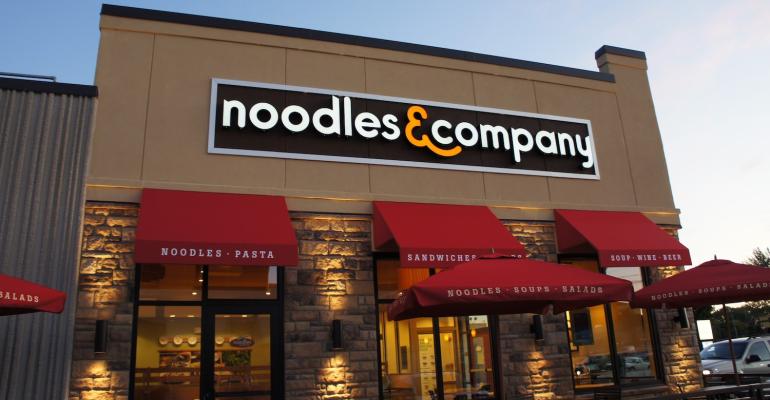Noodles & Company has spent the past few years rounding out its menu, and of course it also spent the past three years coping with a global pandemic, inflation, supply-chain issues, and a labor crunch, but with commodity prices moderating and labor shortages less dire, now the fast-casual chain is turning its attention to technology, specifically digital menu boards which it will roll out systemwide by the end of the year, company executives said Wednesday.
In a conference call announcing fourth-quarter and annual results, CEO Dave Boennighausen said the company would spend around $10 million on the digital menu boards at the Broomfield, Colo.-based chain’s 368 company-owned restaurants, and he expected a good return on investment.
“As an example of the potential for digital menu boards, during the holiday season we leveraged these boards to promote gift cards more actively, resulting in gift card sales at restaurants with digital menu boards that were double of those without,” he said. “Additionally, digital menu boards support the flexibility to quickly implement changes to featured menu items and in pricing.”
Chief financial officer Carl Lukach later told Nation’s Restaurant News that the digital boards would allow the chain to test dynamic pricing — charging different prices for items at different times of day.
“Dynamic pricing is absolutely part of the strategy,” he said.
“Digital menu boards allow us to adjust by market, by tier, by menu item and really implement the pricing we want to take as we test the menu price,” he said, adding that the technology allows them to be “more prescriptive and surgical” in their pricing.
“We are getting way more nimble about our ability to test menu items, enact pricing changes and just react to guest preferences,” he added.
Lukach said that, although 80% of meals from Noodles & Company are eaten off-premises, most guests — almost 75% — still enter the restaurant either to eat there or to pick up their orders, so having digital signage is helpful.
“We can use digital menu boards to feature items that we want to push heavier. We can feature more premium-margin products, [or] LEANguini, which is the high-protein low-net-carb dish that we innovated with last year,” he said.
The LEANguini is the latest of the chain’s culinary innovations, preceded in previous years by more indulgent stuffed tortelloni, lower-carbohydrate cauliflower gnocchi, and zucchini noodles which it rolled out in 2018.
In terms of labor, Boennighausen told investors that the restaurants were fully staffed at levels “at or better than pre-COVID levels.”
He added that over the past four months general manager turnover rates have been more than 30% better than the same timeframe a year ago.
“Improved staffing has yielded meaningful improvement in guest metrics such as friendliness, taste of food, and overall net promoter score, while average cook times thus far in 2023 are nearly 45 seconds better than what they were just a few months ago,” he said.
Although 2022 was challenging, the quarter ended Jan. 3, 2023, was strong. EBIDTA was 101.6% higher than a year earlier at $9.9 million, up from $4.9 million.
Total revenue was up 18.9% to 136.5 million from $114.8 million. Net income was $1 million, or 2 cents per share, compared to a net loss of $4.7 million or negative 10 cents per share in the fourth quarter of 2021.
Same-store sales were up 10.2% for company-owned restaurants and 1.3% for the 93 franchised restaurants in the system, resulting in systemwide same-store sales of 8.7%.
Five company-owned restaurants were opened during the quarter, with an additional two units opened so far this year.
For the year ended Jan. 3. 2023, the chain reported a net loss of $3.3 million, or 7 cents per share, on revenue of $509.5 million, up by 7.2% from $475.2 million in fiscal 2021.
Same-store sales were up 5.6% systemwide — 6% at company-owned restaurants and 3.4% at franchised locations.
Lukach said in the conference call that he expected same-store sales to increase in the high single digits in the first quarter of 2023, “driven by the momentum we have in the business and our strong January results.”
Chicken prices, which account for about 12% of Noodles’ cost of goods sold, have come down since the highs of last year, and, more significantly, the chain has locked in pricing for chicken and other key products for the remainder of 2023.
Unlike at many other chains, traffic was up at Noodles & Company in the fourth quarter, by 10.2% compared to the fourth quarter of 2021, and price increases implemented last May didn’t seem to discourage customers, who Boennighausen said didn’t trade down to lower-priced items.
Contact Bret Thorn at [email protected]





